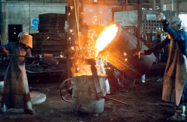With two new cement plants coming online within the past few months, Nigeria’s cement production capacity has increased substantially. This expansion should mean the domestic production will not only be able to meet the demands of the local market – which has been subject to significant price volatility in recent years – but also export to regional economies.
In early February, Dangote Cement inaugurated a $1bn plant, located in Ibese in Ogun state and capable of producing 6m tonnes of cement per annum. With this new facility − the company’s third − Dangote can now manufacture 20.25m tonnes of cement every year, the firm said.
Lafarge WAPCO, the local subsidiary of global building materials company Lafarge, inaugurated a new 2.5m-tonne plant in Ogun state in December 2011. The new plant, Ewekoro II, which represents an investment of N75bn ($472.05m), will bring the company’s total domestic annual output to around 8m tonnes.
According to Aliko Dangote, the CEO of Dangote Cement, further expansion is also in the works for the company. Specifically, the firm plans to boost production at its facility in Kogi state within the next two years, increasing its capacity from 10.25m to 15m tonnes per year.
The new facilities from Dangote and Lafarge represent very recent developments in what is, in fact, a much longer trend, as the government has pushed to ensure domestic self-sufficiency in cement production. The country’s annual cement manufacturing capacity has grown rapidly in recent years, rising from 1.89m tonnes in 2003 to 8m tonnes in 2009.
According to the Cement Manufacturers Association of Nigeria (CMAN), 10.1m tonnes of locally produced cement entered the market in 2010, which accounted for 64% of total market demand of 15.5m tonnes. Domestic demand rose in 2011, reaching between 17m and 18m tonnes, according to some estimates. This growth has come on the back of major infrastructure investments by the government, in addition to expansion in housing projects.
While imports have been required in the past to meet local demand – often resulting in unreliable supply and notable price swings – the new facilities from Dangote and Lafarge may render them unnecessary. Indeed, the government has for some time considered banning imports, a move that has become more realistic with the recent opening of the new factories.
Jean-Christophe Barbant, the country manager of Lafarge, told OBG that he is confident the government will impose a ban in the near future, and that the new capacity should be sufficient to stabilise prices. In early 2011, retail prices soared to more than N2000-N2200 ($13-14) per 50-kg bag due to an increase in the price of diesel, but they have since come down to more usual levels of around N1600-1800 ($10-11) per bag, depending on the location.
Should domestic supply be sufficient to meet demand in the Nigerian cement market, manufacturers also have the option to export their goods. Indeed, at the inauguration ceremony for the new facility in Ogun state, Dangote noted that, “With the commissioning of the Ibese plant, Nigeria has been transformed from major importer of cement to self-sufficient in production and export”.
In the past, Dangote has identified the member states of the Economic Community of West African States (ECOWAS) as a starting point for the company’s expansion abroad. The firm already has operations throughout the region, including in Ghana, and it has publicly announced intentions to export to Liberia, Sierra Leone and Côte D’Ivoire. Other options for exports include Chad and Niger, with Lafarge already exporting to the latter in small amounts.
Despite such glowing prospects, however, challenges do remain, such as an unstable supply of power, which can contribute to higher costs of manufacturing. Some production facilities have their own source of electricity, including Ewekoro II, which has an onsite 90-MW power plant.
Looking ahead, Barbant told OBG that any expansion at the company’s cement facilities would likely include dedicated power capacity. He did note that he is optimistic the government is working to ensure a steady supply of electricity. “It is still too early to abandon plans of fully owned power-generation facilities, but I am upbeat for 2012, as the power reform seems to be moving ahead steadily,” he said.
Ensuring a reliable source of power could help Dangote and Lafarge supply cement at a price that would allow the country’s construction boom to continue unabated. It would also likely encourage other manufacturers already active in Nigeria to increase production, as well as attract new players to the market. This could keep prices low, even in the face of rising demand.

